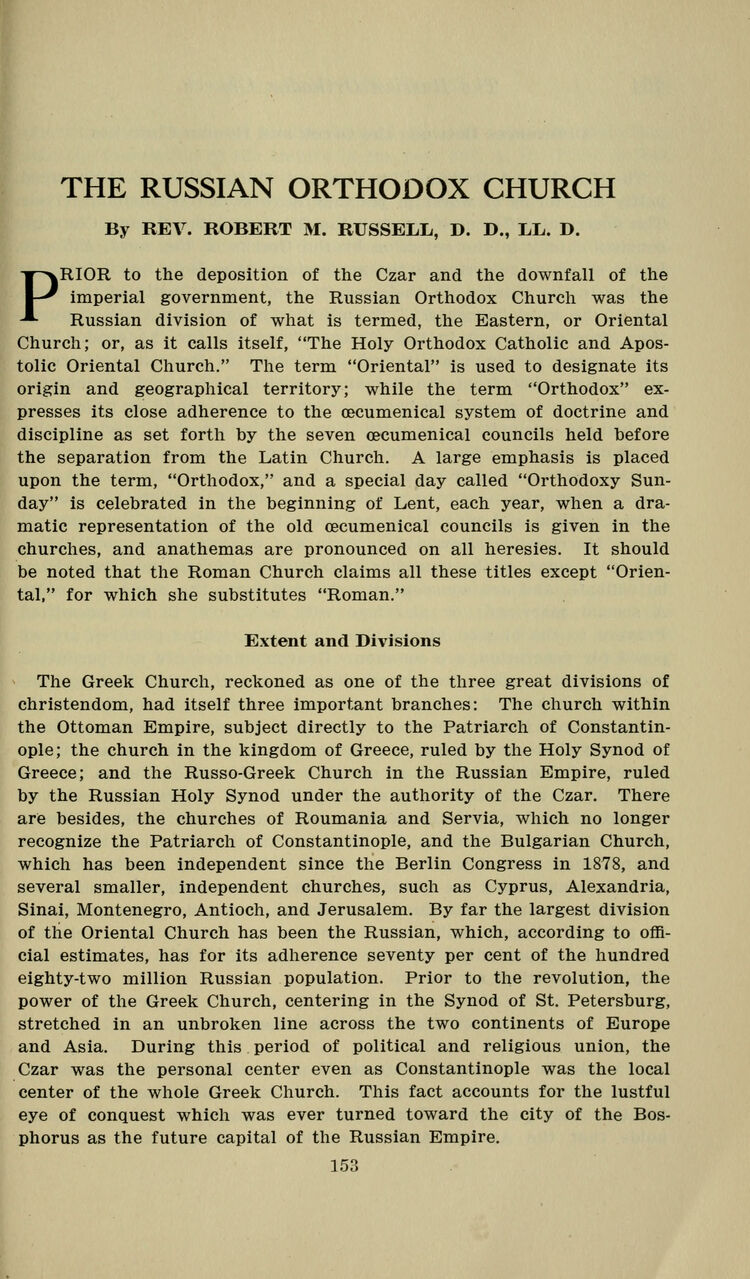
Full resolution (JPEG) - On this page / på denna sida - The Russian Orthodox Church. The Rev. Robert M. Russell, D. D., LL. D. - Extent and Divisions

<< prev. page << föreg. sida << >> nästa sida >> next page >>
Below is the raw OCR text
from the above scanned image.
Do you see an error? Proofread the page now!
Här nedan syns maskintolkade texten från faksimilbilden ovan.
Ser du något fel? Korrekturläs sidan nu!
This page has never been proofread. / Denna sida har aldrig korrekturlästs.
THE RUSSIAN ORTHODOX CHURCH
By REV. ROBERT M. RUSSELL, D. D., LL. D.
PRIOR to the deposition of the Czar and the downfall of the
imperial government, the Russian Orthodox Church was the
Russian division of what is termed, the Eastern, or Oriental
Church; or, as it calls itself, "The Holy Orthodox Catholic and Apos-
tolic Oriental Church." The term "Oriental" is used to designate its
origin and geographical territory; while the term "Orthodox" ex-
presses its close adherence to the oecumenical system of doctrine and
discipline as set forth by the seven oecumenical councils held before
the separation from the Latin Church. A large emphasis is placed
upon the term, "Orthodox," and a special day called "Orthodoxy Sun-
day" is celebrated in the beginning of Lent, each year, when a dra-
matic representation of the old oecumenical councils is given in the
churches, and anathemas are pronounced on all heresies. It should
be noted that the Roman Church claims all these titles except "Orien-
tal," for which she substitutes "Roman."
Extent and Divisions
The Greek Church, reckoned as one of the three great divisions of
Christendom, had itself three important branches: The church within
the Ottoman Empire, subject directly to the Patriarch of Constantin-
ople; the church in the kingdom of Greece, ruled by the Holy Synod of
Greece; and the Russo-Greek Church in the Russian Empire, ruled
by the Russian Holy Synod under the authority of the Czar. There
are besides, the churches of Roumania and Servia, which no longer
recognize the Patriarch of Constantinople, and the Bulgarian Church,
which has been independent since the Berlin Congress in 1878, and
several smaller, independent churches, such as Cyprus, Alexandria,
Sinai, Montenegro, Antioch, and Jerusalem. By far the largest division
of the Oriental Church has been the Russian, which, according to offi-
cial estimates, has for its adherence seventy per cent of the hundred
eighty-two million Russian population. Prior to the revolution, the
power of the Greek Church, centering in the Synod of St. Petersburg,
stretched in an unbroken line across the two continents of Europe
and Asia. During this period of political and religious union, the
Czar was the personal center even as Constantinople was the local
center of the whole Greek Church. This fact accounts for the lustful
eye of conquest which was ever turned toward the city of the Bos-
phorus as the future capital of the Russian Empire.
153
<< prev. page << föreg. sida << >> nästa sida >> next page >>